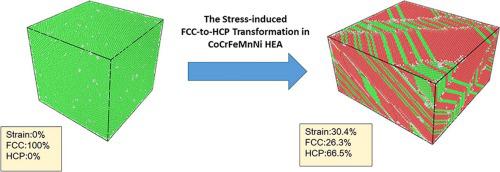当前位置:
X-MOL 学术
›
Comp. Mater. Sci.
›
论文详情
Our official English website, www.x-mol.net, welcomes your feedback! (Note: you will need to create a separate account there.)
Atomistic simulations of the face-centered-cubic-to-hexagonal-close-packed phase transformation in the equiatomic CoCrFeMnNi high entropy alloy under high compression
Computational Materials Science ( IF 3.3 ) Pub Date : 2020-11-01 , DOI: 10.1016/j.commatsci.2020.109864 Kang-Tien Hsieh , You-Yi Lin , Chi-Hung Lu , Jer-Ren Yang , Peter K. Liaw , Chin-Lung Kuo
Computational Materials Science ( IF 3.3 ) Pub Date : 2020-11-01 , DOI: 10.1016/j.commatsci.2020.109864 Kang-Tien Hsieh , You-Yi Lin , Chi-Hung Lu , Jer-Ren Yang , Peter K. Liaw , Chin-Lung Kuo

|
Abstract We performed the modified-embedded-atom-method (MEAM) based molecular dynamics (MD) simulations to investigate the plastic deformation and phase transformation behaviors in the CoCrFeMnNi HEA under high compression at room temperature. Our MD simulations revealed that the stress-induced phase transformations in the CoCrFeMnNi HEA are strongly crystal orientation-dependent. The [0 0 1] uniaxial compression can induce the significant face-centered-cubic (fcc) -to-hexagonal-close-packed (hcp) phase transformation via successive emissions of partial dislocations from the extended stacking faults, twin boundaries and hcp-lamellas created during the early stage of deformation. As for the [1 1 0] and [1 1 1] uniaxial compressions, however, the transformed hcp atoms can simply form the intrinsic/extrinsic stacking faults. Although the [0 0 1] uniaxial compression produced a much lower dislocation density than the other two systems, it induced much more constituents transformed into the hcp atoms at the end of phase transformation. Our results clearly indicated that the deformation twin boundaries and extended hcp-lamellas play a critical role in facilitating the stress-induced fcc-to-hcp phase transformation in the CoCrFeMnNi HEA. Furthermore, it was found that the phase transformation in the CoCrFeMnNi HEA can be effectively facilitated by a large deviatoric compressive stress while it may tend to be significantly retarded by a hydrostatic compression. Our results also showed that the plastic deformation behaviors in Ni under high compression are very similar to those occurred in the CoCrFeMnNi HEA though nearly all the hcp atoms can simply constitute the intrinsic/extrinsic stacking faults without the formation of any bulk hcp phase in the fcc lattice. The main discrepancy in the phase transformation behaviors between the Ni and CoCrFeMnNi HEA can be largely attributed to the much lower stacking fault energy of the CoCrFeMnNi HEA than other fcc metals.
中文翻译:

等原子 CoCrFeMnNi 高熵合金在高压缩下面心立方到六方密堆积相变的原子模拟
摘要 我们进行了基于改进嵌入原子方法 (MEAM) 的分子动力学 (MD) 模拟,以研究 CoCrFeMnNi HEA 在室温高压缩下的塑性变形和相变行为。我们的 MD 模拟表明,CoCrFeMnNi HEA 中的应力诱导相变与晶体取向密切相关。[0 0 1] 单轴压缩可以通过从扩展的堆垛层错、孪晶界和 hcp- 连续发射部分位错来引起显着的面心立方 (fcc) 到六方密堆积 (hcp) 相变在变形的早期阶段产生的薄片。然而,对于 [1 1 0] 和 [1 1 1] 单轴压缩,转变的 hcp 原子可以简单地形成内在/外在堆垛层错。尽管 [0 0 1] 单轴压缩产生的位错密度比其他两个系统低得多,但它在相变结束时诱导了更多的成分转化为 hcp 原子。我们的结果清楚地表明,变形孪晶边界和扩展的 hcp 薄片在促进 CoCrFeMnNi HEA 中应力诱导的 fcc 到 hcp 相变方面起着关键作用。此外,发现大偏压应力可以有效促进 CoCrFeMnNi HEA 中的相变,而静水压缩可能会显着延缓相变。我们的结果还表明,Ni 在高压缩下的塑性变形行为与 CoCrFeMnNi HEA 中发生的非常相似,尽管几乎所有的 hcp 原子都可以简单地构成内在/外在的堆垛层错,而不会在 fcc 中形成任何体 hcp 相格子。Ni 和 CoCrFeMnNi HEA 之间相变行为的主要差异主要归因于 CoCrFeMnNi HEA 的堆垛层错能比其他 fcc 金属低得多。
更新日期:2020-11-01
中文翻译:

等原子 CoCrFeMnNi 高熵合金在高压缩下面心立方到六方密堆积相变的原子模拟
摘要 我们进行了基于改进嵌入原子方法 (MEAM) 的分子动力学 (MD) 模拟,以研究 CoCrFeMnNi HEA 在室温高压缩下的塑性变形和相变行为。我们的 MD 模拟表明,CoCrFeMnNi HEA 中的应力诱导相变与晶体取向密切相关。[0 0 1] 单轴压缩可以通过从扩展的堆垛层错、孪晶界和 hcp- 连续发射部分位错来引起显着的面心立方 (fcc) 到六方密堆积 (hcp) 相变在变形的早期阶段产生的薄片。然而,对于 [1 1 0] 和 [1 1 1] 单轴压缩,转变的 hcp 原子可以简单地形成内在/外在堆垛层错。尽管 [0 0 1] 单轴压缩产生的位错密度比其他两个系统低得多,但它在相变结束时诱导了更多的成分转化为 hcp 原子。我们的结果清楚地表明,变形孪晶边界和扩展的 hcp 薄片在促进 CoCrFeMnNi HEA 中应力诱导的 fcc 到 hcp 相变方面起着关键作用。此外,发现大偏压应力可以有效促进 CoCrFeMnNi HEA 中的相变,而静水压缩可能会显着延缓相变。我们的结果还表明,Ni 在高压缩下的塑性变形行为与 CoCrFeMnNi HEA 中发生的非常相似,尽管几乎所有的 hcp 原子都可以简单地构成内在/外在的堆垛层错,而不会在 fcc 中形成任何体 hcp 相格子。Ni 和 CoCrFeMnNi HEA 之间相变行为的主要差异主要归因于 CoCrFeMnNi HEA 的堆垛层错能比其他 fcc 金属低得多。


























 京公网安备 11010802027423号
京公网安备 11010802027423号